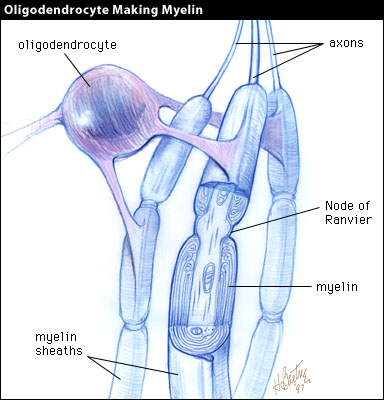 We are finally at my area of expertise -- neuroscience -- and we started by reading this page for homework and having a quiz show based on it. Here were some of the main facts we went over:
We are finally at my area of expertise -- neuroscience -- and we started by reading this page for homework and having a quiz show based on it. Here were some of the main facts we went over:- Brain cells or nerve cells are called neurons.
- Neurons have a nucleus, cytoplasm, mitochondria, and other organelles that are typical of animal cells.
- Neurons communicate with each other.
- The way they connect and communicate is through structures called synapses.
- Synapses are places where neurons communicate, but there is a teeny tiny gap between the two cells.
- The brain has approximately 100 billion neurons, and approximately 1 quadrillion synapses.
- The adult human brain weighs about 3 pounds
- Neurons have a long, skinny part called the axon that sends the message to the next cell.
- If you laid all of an adult human's neurons end to end, it would be about 600 miles.
- The brain is about 2% of the total body weight for an adult.
- Most neuroscientists have had 12 years of grade school, 4 years of college, and 4-7 years of graduate school.
 We also discussed the insulation around neurons. You can see in the image above that there are rod-like things going down the axon. That is actually from cells called oligodendrocytes that are near neurons that wrap themselves around the neurons to insulate them, like we use rubber to insulate wires. The insulation makes the message travel faster, and as our brains get more insulation around their neurons, we become more able to do things. Babies have hardly any of it, and new skills develop as their brains
develop in this way. If you lose the insulation around your neurons, you become disabled in various ways because the brain doesn't function as well.
We also discussed the insulation around neurons. You can see in the image above that there are rod-like things going down the axon. That is actually from cells called oligodendrocytes that are near neurons that wrap themselves around the neurons to insulate them, like we use rubber to insulate wires. The insulation makes the message travel faster, and as our brains get more insulation around their neurons, we become more able to do things. Babies have hardly any of it, and new skills develop as their brains
develop in this way. If you lose the insulation around your neurons, you become disabled in various ways because the brain doesn't function as well.
The insulation is very fatty, and because of that, areas of the brain and spinal cord with a lot of insulation look white. Areas that mostly have the cell bodies of the neurons look gray. That's why these areas are called white matter and gray matter -- they really look white and gray when you dissect them, as we will see.
We took a look at our sheep brains and saw that they have a thin
membrane over them. This is not much real protection compared to the skull, but it helps regulate the fluid pressure inside the brain, which is very important. Too much or too little pressure inside the brain can be a disaster! We also saw the brainstem at the base of the brain, which is a huge bundle of mostly axons that are going to the spinal cord. We noticed that the surface feels smooth, but you can see all sorts of wrinkles and twists like a small intestine. We will discuss why that is and what it means. Lastly, we weighed our brains, and they weighed about 150g. Not very much! They are very small compared with human brains!
| What our sheep brains look like |

No comments:
Post a Comment